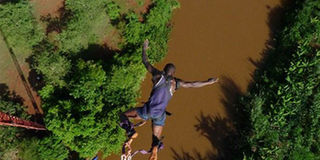Extreme sportsmen: they risk life and limb to get adrenaline highs

Bungee jumping in Sagana, along River Tana, is gaining popularity. Photo/File
What you need to know:
- Bungee jumping, plunging and street racing are certainly not sports for the fainthearted because of the inherent risks, yet there are those who love these sports for the very reasons that make them so frightening for others. Do they do it strictly for fun, or are there other reasons for participating in what some consider suicidal?
It a pleasant Saturday morning, and twenty-something-year-old Paul Ndeda and his friends are all out to have fun, so they head for the Sagana Rapids Camp.
And since they want to start their day a high note, they head to the point where a 60-metre high structure operated by Andreas Reblin stands. Ndeda goes up the structure and gets firmly fastened with a cord coiled round him, from his waist to his feet.
He moves to the edge of the platform and prepares to jump while his friends cheer and urge him on. But he hesitates for a moment, apparently summoning the courage to take the leap, a move that will see him plummet headlong at a terrific speed.
Finally, he closes his eyes, yells loudly and jumps, to the wild cheering of his friends.
Next in line is a young woman. Excited, she scales the ladder to the top of the structure, gets strapped just like Ndeda was and moves to the edge of the platform. Her friends down below urge her on, screaming, clapping and cheering.
But she loses her initial enthusiasm and seems to get cold feet. Instead of jumping, she unstraps herself, climbs down, an undescribable look on her face.
“I can’t. I have a baby. I have a family, who will take care of them?” she asks no one in particular.
Still, she remains upbeat, perhaps because he team members are in such a jovial mood.
Later, DN2 catches up with Ndeda and asks how he felt before he jumped. Well, he was a little nervous, his heartbeat increased and his legs even shook a little. Two questions went through his mind: “Am I doing the right thing” and “What if….?” But hd did it all the same.
Welcome to the world of extreme sports, where athletes risk life and limbe for an adrenaline rush.
Take “the plunge” for instance, which is offered at some of the local campsites located near waterfalls. Here, the thrillseeker leaps from the edge of a waterfall into the raging waters below.
These sports are certainly not for the fainthearted due to the high risks involved, but that is precisely what makes them exciting to enthusiasts. Indeed, according to one man who has taken the plunge, “For the first 10 seconds you’re in the water, you just don’t know if you’re alive or dead.”
Although there is debate over the classification of extreme sports, it includes a range of activities that are characterised by extreme physical exertion, speed, height and in some cases, specialised gear.
There is one difference between these activities and other sports, though: the possibility of getting hurt, and even dying is high. Yet it is their dicey nature that makes them popular.
Ever seen street racing? Perhaps only in the movie Fast and Furious, or perhaps read about it in an action thriller or some other novel. Well, you can witness it live in Nairobi, where they are organised in the dead of the night.
One route if from Westlands, via Waiyaki way and onto Mombasa Road.
The drivers, mostly men, are from of age groups and highly skilled. They test themselves and their machines to the limit as they cruise at terrifying speeds, always on the lookout for the police since the races are illegal.
Occasionally, they are joined by bikers. These men operate on the principle, “Gari ndio inafaa iumie, sio wewe, (only the car should suffer damage, not you).’
And so they engage in a contest of skill, wit, tenacity and courage in an activity in which the end can be exhilarating – or chilling.
Since it seems contraditory that one should seeking fun by endangering DN2 sought to know what motivates people to engage in extreme sports.
Psychologist Hamida Ahmed of Diamond in the Rough Consultants calls such individuals adrenaline junkies. The term refers to individuals who get high on the secretion of their own adrenaline.
When their bodies and minds are at their most active, h when the hairs on their necks stand and little beads of sweat dot the tips of their noses and their hearts race beyond normal, they feel alive.
“These people look for the sensation one experiences when they put their life on the line. Ironically, it is a true sense of feeling alive. The few minutes of the adrenaline rush are like walking on air,” says Ms Ahmed.
Another reason some people get involved in such sports, she says, is that they want to get a high similar to that one gets from taking drugs.
She says that when someone goes for a midnight street car race or to a camp that offers night walks on hippo paths where they risk running into a hippo, their body produces large amounts of natural chemicals like dopamine, which tend to generate pleasurable feelings similar to those experienced when one takes alcohol or stimulating drugs, or has sex.
The brain does not not differentiate between the degree of safety concerning the activities you participate in, whether it is bungee jumping or being in love, the most important thing is that the activity results in the release of the hormones involved in the brain’s reward system.
Meanwhile, Mr William Kinuthia, CEO and chief facilitator at the Sagana Rapids Camp, looks at it as a social issue.
“Most of the activities that people engage in today limit their involvement to that of passive spectators. This is what some young people are going against. They want to be in the sport. They want to feel part of the sport. These people are so tired of being guided and guarded in their lives that some of them will not read or want to listen to instructions when they have already made up their mind to get into an extreme sport,” he says.
For his part, Mark Savage, founder of Savage Wilderness Safaris, which runs white water rafting and bungee jumping, among other activities, sees the growing popularity of extreme sports or extreme leisure activities as a response to a sedentary, dull and monotonous life.
“People like to try out new things. They want to spice up their lives a bit,” says the man who has been in the safari business for decades now. He, however, aknowledges that once in a while, things do go wrong; someone might fall off a raft and hit their head on a rock, or a boat might capsize.
It is notable extreme sportsmen fully understand the dangers of the activities they engage in entail and even sign a waiver before the bungee jump or plunge that exonerate the service provider from any liability in case they get hurt.
Meanwhile, psychologist Anne Muite says some of the people who engage in dangerous sports have illusions of invulnerability, so they believe that they are immune to the misfortunes that befall other people, like accidents.
They also do not differentiate between the ideal and reality. Besides, she adds, some might be driven to such activities by “an imaginary audience”. This is the belief that people are watching them and they will react or behave in a particular way, never mind that such an audience might not be there.
Could these be signs of a changing society? Perhaps.
In the past, individuals from different communities had avenues for letting off steam such as wrestling matches, hunting or engaging in bullfighting. These activities were risky and adventurous and could be used to measure courage as well as competitiveness. As society changes, there are fewer avenues for releasing the inherent inertia in most people thanks to our modern lifestyles.
So, what propels these fun seekers? Ms Ahmed classifies them as sanguine-type personalities, who are extreme optimists and go out of the way too seek fun. They are sensation seekers who derive pleasure from highly arousing experiences and can be said to “drink life” and enjoy it to the fullest, she says.
Dr Kiplagat Chepkong’a, a sociology and criminology lecturer at the University of Nairobi, believes that the rise in the extreme sports is partly attributable to the assimilation of Western culture, which has been brought about by rapid urbanisation.
“Most of these young people have limited opportunities for self-expression. This forces them to strike it out on their own, but influenced by a Western way of life,” he says.
However, he wonders whether such activities can be truly considered fun, given that they border on the suicidal, and whether one should be allowed to endanger their own life in pursuit of fun.
Taking a similarly sociological angle is Paul Namai, a lecturer at Maasai Mara University in Narok, who cites group polarisation as one of the reasons people engage in such sports.
“People in groups might be willing to adopt behaviour that is more extreme compared to their individual behavioural tendencies, they might be willing to take decisions that are risky or even daring. This often happens where group decision-making occurs. In a group, individuals initially perceive themselves as being more extreme than the other members of the group.
“They also believe they are fairer, more right-minded, more liberal, etc. When they discover that their position is not very different from the others in the group, they shift, or become polarised, to show that they are even more right-minded, more liberal, and so on. This is where the problem lies because you never know the extent to which an individual will go to prove their worth.
He says that this could explain why most of these extreme sports, though performed by individuals, are mostly performed when people are in a group, or when there is a known group present.
Looks like there might be more to these sports than just having fun.




